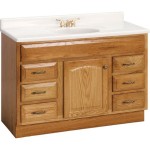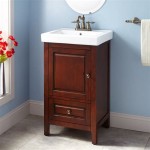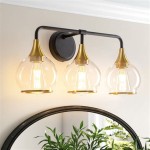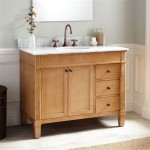Average Height of Bathroom Vanities: A Comprehensive Guide
Selecting the appropriate height for a bathroom vanity is a crucial aspect of bathroom design, impacting both functionality and aesthetics. While personal preference plays a role, understanding the average height and available variations ensures a comfortable and ergonomic experience for all users. This article will provide a comprehensive overview of bathroom vanity heights, covering standard dimensions, factors influencing height selection, and considerations for customization.
The primary function of a bathroom vanity is to provide a convenient surface for daily routines, such as washing hands, brushing teeth, and applying cosmetics. An improperly sized vanity can lead to discomfort, strain, and ultimately, a less enjoyable bathroom experience. Understanding the nuances of vanity height allows homeowners and designers to create spaces that are both visually appealing and highly functional.
Standard Bathroom Vanity Heights
The traditional standard height for bathroom vanities in the United States has historically been 30 to 32 inches. This height was originally designed to accommodate the average height of adults at the time. However, as average heights have increased, the demand for taller vanities has also grown. Consequently, a new "comfort height" standard has emerged, offering a more ergonomically sound option for many users. It's important to note that these measurements refer to the distance from the floor to the top of the vanity countertop.
The "comfort height," also referred to as "ADA compliant" height, typically ranges from 34 to 36 inches. This height is designed to reduce strain on the back and neck, making it a more comfortable option for taller individuals and those with mobility issues. Comfort height vanities are increasingly popular in modern bathroom designs, offering a more practical and accessible option for a wider range of users.
While 30-32 inches and 34-36 inches are considered standard heights, variations exist. Some manufacturers offer vanities in heights ranging from 29 inches for children's bathrooms to custom heights tailored to specific user needs. These variations provide flexibility in design and allow homeowners to create bathrooms that are truly personalized and optimized for their individual requirements.
It is essential to consider the overall dimensions of the vanity, including its width and depth, in addition to its height. These dimensions will affect the overall layout of the bathroom and impact the flow of movement within the space. A vanity that is too large for the available space can make the bathroom feel cramped and uncomfortable. Conversely, a vanity that is too small may not provide sufficient storage or counter space.
Factors Influencing Vanity Height Selection
Several factors should be taken into consideration when selecting the appropriate height for a bathroom vanity. These factors include the height of the primary users, the overall design aesthetic of the bathroom, and any specific accessibility requirements. A thoughtful assessment of these factors will ensure that the chosen vanity height is both functional and aesthetically pleasing.
The height of the primary users is perhaps the most important factor to consider. If the bathroom is primarily used by children, a shorter vanity may be more appropriate. Conversely, if the bathroom is primarily used by taller adults, a comfort height vanity may be the better option. In households with users of varying heights, a compromise may be necessary, or adjustable-height vanities can be considered to accommodate diverse needs. Consider that while shorter users can adapt to higher vanities with stools, taller users will consistently experience discomfort from a vanity that is too low.
The overall design aesthetic of the bathroom can also influence vanity height selection. In traditional bathrooms, a lower vanity height may be more in line with the overall design style. In modern bathrooms, a comfort height vanity may be more appropriate. The vanity should complement the other fixtures and finishes in the bathroom, creating a cohesive and visually appealing space. Consider the visual impact of the vanity height on the overall room. A higher vanity may make a small bathroom feel even smaller, while a lower vanity may give a larger bathroom a more spacious feel.
Accessibility requirements are another important consideration. The Americans with Disabilities Act (ADA) provides guidelines for bathroom accessibility, including specific requirements for vanity height. ADA-compliant vanities typically have a height of 34 inches and provide clear knee space underneath the sink. If the bathroom is intended to be accessible to individuals with mobility issues, it is essential to ensure that the vanity meets these requirements.
The type of sink being installed can also influence the perceived height of the vanity. Vessel sinks, for example, sit on top of the vanity countertop, adding several inches to the overall height. When using a vessel sink, it is important to select a vanity that is slightly shorter than the standard height to ensure that the top of the sink is at a comfortable level. Undermount sinks, on the other hand, are installed underneath the countertop, resulting in a lower overall height. The sink choice and mounting configuration should be factored into the height selection.
Customization and Alternatives to Standard Heights
While standard vanity heights offer a convenient starting point, customization allows for a truly personalized bathroom experience. Custom vanities can be built to any height, providing the flexibility to accommodate specific user needs and design preferences. This option is particularly appealing for individuals with unique height requirements or those seeking a specific aesthetic.
Adjustable-height vanities represent another innovative solution. These vanities utilize mechanisms that allow the height to be easily adjusted, accommodating users of varying heights or changing needs over time. Adjustable-height vanities are particularly well-suited for families with children or individuals with disabilities, providing a versatile and adaptable solution. The mechanisms for adjustment can range from simple manual systems to more sophisticated motorized options.
Floating vanities, which are mounted to the wall without legs, offer a unique aesthetic and can be installed at any desired height. This type of vanity provides a modern and minimalist look, while also making it easier to clean the floor underneath. The mounting height of a floating vanity should be carefully considered to ensure that it is both comfortable and visually appealing. The structural support of the wall must be carefully assessed to ensure it can safely bear the weight of the vanity and its contents.
When considering custom or alternative vanity heights, it is important to consult with a qualified contractor or designer. They can provide valuable guidance on design considerations, installation requirements, and structural implications. A professional can also help ensure that the chosen vanity height meets all applicable building codes and accessibility standards.
Ultimately, the ideal height for a bathroom vanity is the height that provides the most comfortable and functional experience for the primary users. By carefully considering the factors outlined in this article and exploring the available options, homeowners and designers can create bathrooms that are both beautiful and practical.
Consider also the lighting in the bathroom. A vanity that is too high can cast shadows that make tasks like applying makeup difficult. Similarly, a vanity that is too low may require users to bend over, causing strain on the back. Adequate lighting, combined with a properly sized vanity, can enhance the functionality and overall enjoyment of the bathroom.
The cost of a vanity can vary depending on its size, materials, and features. Custom vanities and adjustable-height vanities tend to be more expensive than standard vanities. However, the long-term benefits of a properly sized and well-designed vanity can outweigh the initial cost. Investing in a quality vanity that meets the specific needs of the users can improve comfort, accessibility, and overall bathroom satisfaction.
Finally, consider the resale value of the home. While personal preferences should be prioritized, it is important to choose a vanity height that will appeal to a wide range of potential buyers. A comfort height vanity is generally considered a desirable feature and may increase the resale value of the home. However, it is important to strike a balance between personal preference and market appeal. A neutral design and well-chosen height are generally safe choices for maximizing resale potential.

What Is The Standard Bathroom Vanity Height Size Guide

Bathroom Vanity Height Choosing The Perfect Fit For Your Space

What Is The Standard Bathroom Vanity Height Size Guide

What Is The Standard Bathroom Vanity Height Bfy Mirror

What Are Standard Bathroom Vanity Sizes And Size Do I Need Wide Canvas

What Is The Standard Height Of A Bathroom Vanity

How To Choose Your Bathroom Vanity Height

How To Choose The Best Bathroom Sink Height A Complete Guide

Plan Your Bathroom By The Most Suitable Dimensions Guide Engineering Discoveries

Bathroom Vanity Heights Sizes Everything Explained







